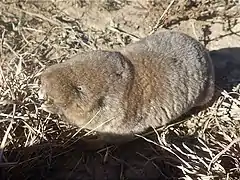| Cryptomys | |||
| J.E. Gray, 1864[1] | |||
 Przedstawiciel rodzaju – ziemioryjka hotentocka (C. hottentotus) | |||
| Systematyka | |||
| Domena | |||
|---|---|---|---|
| Królestwo | |||
| Typ | |||
| Podtyp | |||
| Gromada | |||
| Podgromada | |||
| Rząd | |||
| Podrząd | |||
| Infrarząd | |||
| (bez rangi) | incertae sedis[2][3] | ||
| Rodzina | |||
| Rodzaj |
ziemioryjka | ||
| Typ nomenklatoryczny | |||
|
Georychus holosericeus Wagner, 1842 (= Bathyergus hottentotus Lesson, 1826) | |||
| Synonimy | |||
|
| |||
| Gatunki | |||
| |||
Ziemioryjka[6] (Cryptomys) – rodzaj ssaków z rodziny kretoszczurowatych (Bathyergidae).
Zasięg występowania
Rodzaj obejmuje gatunki występujące w Afryce Południowej[2][7].
Morfologia
Długość ciała (bez ogona) 100–185 mm, długość ogona 8–27 mm; masa ciała 98–153 g[8][9].
Systematyka
Rodzaj zdefiniował w 1864 roku angielski zoolog John Edward Gray na łamach Proceedings of the Zoological Society of London[1]. Na gatunek typowy Gray wyznaczył (oznaczenie monotypowe) ziemioryjkę hotentocką (C. hottentotus).
Etymologia
- Cryptomys: gr. κρυπτος kruptos ‘ukryty’; μυς mus, μυος muos ‘mysz’[10].
- Coetomys: gr. κοιτος koitos ‘sen, spoczynek’; μυς mus, μυος muos ‘mysz’[11]. Gatunek typowy: Gray wymienił dwa gatunki – Bathyergus caecutiens Brants, 1827 (= Bathyergus hottentotus Lesson, 1826) i Bathyergus damarensis Ogilby, 1838 – z których typem nomenklatorycznym jest Bathyergus caecutiens Brants, 1827 (= Bathyergus hottentotus Lesson, 1826).
- Typhloryctes: gr. τυφλος tuphlos ‘ślepy’; ορυκτης oruktēs ‘kopacz’, od ορυσσω orussō ‘kopać’[12]. Gatunek typowy: Fitzinger wymienił dwa gatunki – Georychus ochraceo-cinereus Heuglin, 1864 i Typhloryctes coecutiens Fitzinger, 1867[uwaga 1] (= Bathyergus hottentotus Lesson, 1826) – z których typem nomenklatorycznym jest Bathyergus caecutiens Brants, 1827 (= Bathyergus hottentotus Lesson, 1826).
Podział systematyczny
Do rodzaju należą następujące współcześnie występujące gatunki[3][9]:
- Cryptomys mahali (Roberts, 1913)
- Cryptomys nimrodi (de Winton, 1896)
- Cryptomys hottentotus (Lesson, 1826) – ziemioryjka hotentocka
- Cryptomys natalensis (Roberts, 1913)
- Cryptomys pretoriae (Roberts, 1913)
Opisano również gatunek wymarły z pliocenu dzisiejszej Południowej Afryki[13]:
- Cryptomys broomi Denys, 1998
Uwagi
- ↑ Kombinacja nazw i nieuzasadniona poprawka Bathyergus caecutiens Brants, 1827.
Przypisy
- 1 2 Gray 1864 ↓, s. 124.
- 1 2 C.J. Burgin, D.E. Wilson, R.A. Mittermeier, A.B. Rylands, T.E. Lacher & W. Sechrest: Illustrated Checklist of the Mammals of the World. Cz. 1: Monotremata to Rodentia. Barcelona: Lynx Edicions, 2020, s. 546. ISBN 978-84-16728-34-3. (ang.).
- 1 2 N. Upham, C. Burgin, J. Widness, M. Becker, C. Parker, S. Liphardt, I. Rochon & D. Huckaby: Treeview of Mammalian Taxonomy Hierarchy. [w:] ASM Mammal Diversity Database (Version 1.11) [on-line]. American Society of Mammalogists. [dostęp 2023-10-15]. (ang.).
- ↑ Gray 1864 ↓, s. 125.
- ↑ L. Fitzinger. Versuch einer natürlichen Anordnung der Nagethiere (Rodentia). „Sitzungsberichte der Kaiserlichen Akademie der Wissenschaften. Mathematisch-Naturwissenschaftliche Classe”. 55 (1), s. 502, 1867. (niem.).
- ↑ Nazwy zwyczajowe za: W. Cichocki, A. Ważna, J. Cichocki, E. Rajska-Jurgiel, A. Jasiński & W. Bogdanowicz: Polskie nazewnictwo ssaków świata. Warszawa: Muzeum i Instytut Zoologii PAN, 2015, s. 285. ISBN 978-83-88147-15-9. (pol. • ang.).
- ↑ D.E. Wilson & D.M. Reeder (redaktorzy): Genus Cryptomys. [w:] Mammal Species of the World. A Taxonomic and Geographic Reference (Wyd. 3) [on-line]. Johns Hopkins University Press, 2005. [dostęp 2021-11-16].
- ↑ R. Honeycutt: Family Bathyergidae (African Mole-rats). W: D.E. Wilson, T.E. Lacher, Jr & R.A. Mittermeier: Handbook of the Mammals of the World. Cz. 6: Lagomorphs and Rodents I. Barcelona: Lynx Edicions, 2016, s. 368. ISBN 978-84-941892-3-4. (ang.).
- 1 2 Class Mammalia. W: Lynx Nature Books: All the Mammals of the World. Barcelona: Lynx Edicions, 2023, s. 351. ISBN 978-84-16728-66-4. (ang.).
- ↑ Palmer 1904 ↓, s. 205.
- ↑ Palmer 1904 ↓, s. 195.
- ↑ Palmer 1904 ↓, s. 698.
- ↑ Ch. Denys. Phylogenetic implications of the existence of two modern genera of Bathyergidae (Mammalia, Rodentia) in the Pliocene site of Langebaanweg (South Africa). „Annals of the South African Museum”. 105 (5), s. 268, 1998. (ang.).
Bibliografia
- J.E. Gray. Notes on the species of sand-moles (Georychus). „Proceedings of the Zoological Society of London”. 1864, s. 123–125, 1864. (ang.).
- T.S. Palmer. Index Generum Mammalium: a List of the Genera and Families of Mammals. „North American Fauna”. 23, s. 1–984, 1904. (ang.).